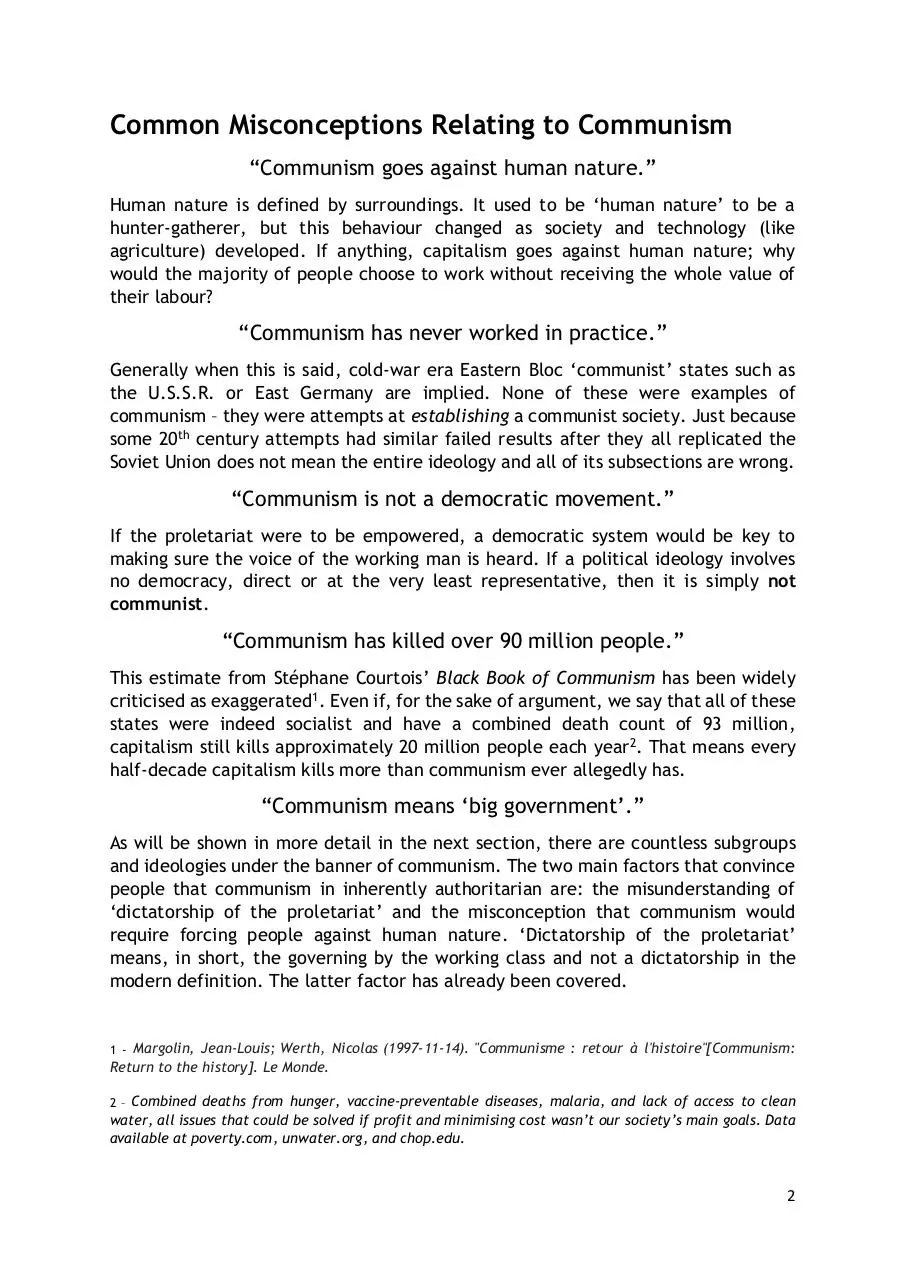Marxism basics (PDF)
File information
Author: Becket
This PDF 1.5 document has been generated by Microsoft® Word 2016, and has been sent on pdf-archive.com on 10/02/2018 at 21:58, from IP address 73.130.x.x.
The current document download page has been viewed 434 times.
File size: 294.41 KB (3 pages).
Privacy: public file



File preview
What is Communism?
By Geoffrey Gimpboi
December 2017
Introduction
This document attempts to outline and define the main aspects of the socialist
movement in a language and format which is easily understood by the average
person. It should be used as a starting point for anyone interested in the
Communist ideology.
Glossary of Common Communist Phrases and Words
Communism:
The general ideology which attempts to establish a
communist society, which is absent of currency,
economic class, a state, or private property and
features collective ownership of the means of
production by the proletariat.
Socialism:
Hard to define. Can sometimes be used synonymously
with communism. Usually used to mean an attempt at
establishing communist society. At the very least,
nationalisation or collectivisation of capitalist
companies/industries.
State:
The organising committee of the ruling class. In short,
the government.
Private Property:
Not to be confused with personal property. The tools,
land, or buildings used by the bourgeoisie to make a
profit.
Bourgeoisie:
The ruling class, or the ‘one-percent’. They exploit the
proletariat’s labour and own the means of production.
Proletariat:
The working class. They work for the bourgeoisie and do
not own the means of production.
Means of Production:
The industries, factories, farms, mines and machinery
which produce goods.
1
Common Misconceptions Relating to Communism
“Communism goes against human nature.”
Human nature is defined by surroundings. It used to be ‘human nature’ to be a
hunter-gatherer, but this behaviour changed as society and technology (like
agriculture) developed. If anything, capitalism goes against human nature; why
would the majority of people choose to work without receiving the whole value of
their labour?
“Communism has never worked in practice.”
Generally when this is said, cold-war era Eastern Bloc ‘communist’ states such as
the U.S.S.R. or East Germany are implied. None of these were examples of
communism – they were attempts at establishing a communist society. Just because
some 20th century attempts had similar failed results after they all replicated the
Soviet Union does not mean the entire ideology and all of its subsections are wrong.
“Communism is not a democratic movement.”
If the proletariat were to be empowered, a democratic system would be key to
making sure the voice of the working man is heard. If a political ideology involves
no democracy, direct or at the very least representative, then it is simply not
communist.
“Communism has killed over 90 million people.”
This estimate from Stéphane Courtois’ Black Book of Communism has been widely
criticised as exaggerated1. Even if, for the sake of argument, we say that all of these
states were indeed socialist and have a combined death count of 93 million,
capitalism still kills approximately 20 million people each year2. That means every
half-decade capitalism kills more than communism ever allegedly has.
“Communism means ‘big government’.”
As will be shown in more detail in the next section, there are countless subgroups
and ideologies under the banner of communism. The two main factors that convince
people that communism in inherently authoritarian are: the misunderstanding of
‘dictatorship of the proletariat’ and the misconception that communism would
require forcing people against human nature. ‘Dictatorship of the proletariat’
means, in short, the governing by the working class and not a dictatorship in the
modern definition. The latter factor has already been covered.
1 - Margolin, Jean-Louis; Werth, Nicolas (1997-11-14). "Communisme : retour à l'histoire"[Communism:
Return to the history]. Le Monde.
2 – Combined deaths from hunger, vaccine-preventable diseases, malaria, and lack of access to clean
water, all issues that could be solved if profit and minimising cost wasn’t our society’s main goals. Data
available at poverty.com, unwater.org, and chop.edu.
2
Sub-ideologies of Communism
There is more to communism than just Stalin or Marx. There are too many separate
ideologies to list every single one, so this section will only cover the core few.
Communism can be primarily split into Anarchism and Orthodox Marxism.
Anarchism includes:
Anarcho-Communism:
Establishment of communist society immediately
post-revolution. No dictatorship of the proletariat
or similar transitionary systems.
Mutualism:
Belief that private property is bad, but markets
have a place post-revolution.
Communalism:
A system of government which involves direct
democracy and is networked across highly
connected worker councils.
Orthodox Marxism includes:
Leninism:
Transition into a communist society via
dictatorship of the proletariat and a central
vanguard party.
Maoism:
Similar to Leninism. Includes belief that
agricultural peasants should lead the revolution.
Stalinism:
Mainly characterised by ‘socialism in one country’,
the belief that a socialist state should strengthen
internally in order to defend itself.
Further Reading
Marx & Engels:
The Communist Manifesto
Wage-Labour and Capital
Value, Price and Profit
Anarcho-Communism:
The Conquest of Bread
Mutualism:
Studies in Mutualist Political Economy
Communalism:
The Next Revolution
Leninism:
The State and Revolution
Maoism:
On Contradiction
Stalinism:
Economic Problems of Socialism in the USSR
3
Download Marxism basics
Marxism basics.pdf (PDF, 294.41 KB)
Download PDF
Share this file on social networks
Link to this page
Permanent link
Use the permanent link to the download page to share your document on Facebook, Twitter, LinkedIn, or directly with a contact by e-Mail, Messenger, Whatsapp, Line..
Short link
Use the short link to share your document on Twitter or by text message (SMS)
HTML Code
Copy the following HTML code to share your document on a Website or Blog
QR Code to this page

This file has been shared publicly by a user of PDF Archive.
Document ID: 0000732829.